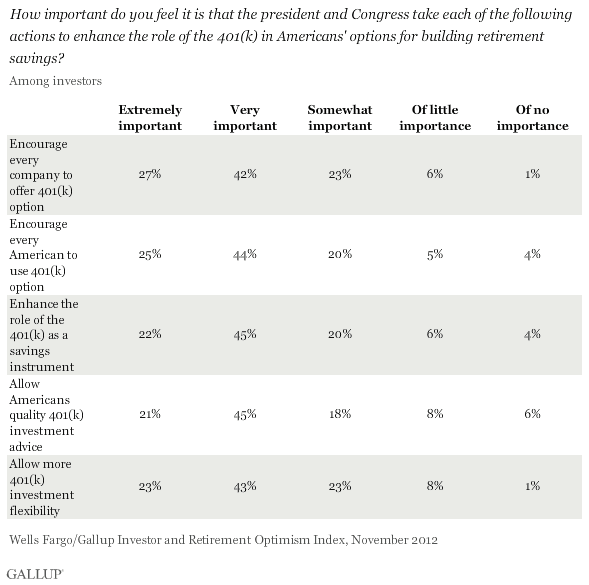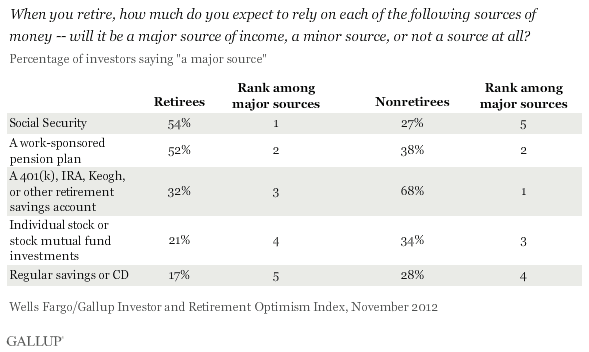PRINCETON, NJ -- More than eight in 10 U.S. investors (83%) say 401(k) and other tax-advantaged accounts are extremely (43%) or very (40%) important to achieving a comfortable retirement, according to a recent Wells Fargo/Gallup Investor and Retirement Optimism Index survey.

The most recent Wells Fargo/Gallup Investor and Retirement Optimism Index survey investigated investor perceptions of the importance of tax-advantaged accounts. This quarterly survey was most recently conducted Nov. 9-17, 2012, with a random sample of 1,024 investors, with about half the sample responding to questions focused on federal policies about tax-advantaged savings.
When asked to rate the importance of the federal government in enhancing the role of the 401(k) in Americans' options for building retirement savings, 69% say it is extremely or very important that the president and Congress find ways to financially encourage every company to offer a 401(k) savings option and to financially encourage all Americans to participate in their employer's 401(k) savings option. A similarly high 67% say it is extremely or very important that leaders seek ways to enhance the role of the 401(k) as a retirement savings investment. Sixty-six percent say it is extremely or very important that the president and Congress should allow Americans with 401(k) retirement savings to obtain more quality investment advice and should allow Americans more investment flexibility with their 401(k).

Most Nonretired Investors Expect to Rely on Tax-Advantaged Accounts for Retirement
One reason so many investors see 401(k) and other tax-advantaged savings accounts as essential to achieving a comfortable retirement likely relates to how they expect to fund their retirement. Sixty-eight percent of nonretirees mention the 401(k), IRA, Keogh, or other tax-advantaged retirement savings accounts as a major source of their retirement income -- the highest percentage of the five alternatives offered. At the same time, 27% of nonretirees say Social Security will be a major source of their future retirement income -- the lowest percentage of the five options. This contrasts sharply with what current retirees say are their major income sources: More than half of current retirees say Social Security is a major source of their retirement income (54%), while 32% say the same about 401(k) and other tax-advantaged accounts.

Consistent with this anticipated shift away from future dependence on Social Security, 58% of investors think it will be unlikely that the system will be there for today's younger Americans when they retire. At the same time, 76% think that strengthening Social Security for younger Americans should be a top or major national priority over the next four years.
Implications
Although the new fiscal cliff legislation addressed many tax issues and raised federal revenues, the president has made clear that he sees tax reform and the need to raise additional tax revenues as part of any future discussions concerning potential spending cuts. In this regard, policymakers could easily include 401(k) and similar accounts in 2013 tax reform discussions. Tax-advantaged savings accounts such as the 401(k) are by definition tax expenditures -- they are a source of forgone potential tax revenues, as are investments like municipal bonds and deductions like the mortgage interest deduction. Consequently, political leaders could place new investment limits on tax savings accounts aimed at increasing federal tax revenues. Such limits might also reduce the ability of those Americans seeking to make these savings a major source of their future retirement income to do so.
On the other hand, when the higher tax rates anticipated as part of the fiscal cliff negotiations go into effect, 401(k) and other tax-advantaged accounts will become even more attractive as retirement savings vehicles because the benefits associated with their special tax treatment increases. Given today's low interest rates on savings, federal government efforts to maintain or enhance tax-advantaged savings would be positive for most Americans retirement outlook.
The importance of 401(k) and other tax-advantaged savings accounts as a way to build retirement savings has increased over the years as many companies no longer offer employee pension plans, but instead offer a tax-advantaged 401(k) plan. The increasing popularity of these accounts helps explain why so many investors are supportive of expanding their use and flexibility.
Survey Methods
The Wells Fargo/Gallup Investor and Retirement Optimism Index results are based on questions asked on the Gallup Daily tracking survey of a random sample of 1,024 U.S. adults, aged 18 and older, living in all 50 U.S. states and the District of Columbia, having investable assets of $10,000 or more from Nov. 9-17, 2012.
For results based on the entire sample of national adults, one can say with 95% confidence that the maximum margin of sampling error is ±3 percentage points.
For results based on the sample of 625 non-retirees, one can say with 95% confidence that the maximum margin of sampling error is ±4 percentage points. For results based on 394 retirees, one can say with 95% confidence that the maximum margin of sampling error is ±5 percentage points. For results based on the 405 respondents answering questions on tax-advantaged savings, one can say with 95% confidence that the maximum margin of sampling error is ±5 percentage points.
Interviews are conducted with respondents on landline telephones and cellular phones, with interviews conducted in Spanish for respondents who are primarily Spanish-speaking. Each sample includes a minimum quota of 400 cellphone respondents and 600 landline respondents per 1,000 national adults, with additional minimum quotas among landline respondents by region. Landline telephone numbers are chosen at random among listed telephone numbers. Cellphone numbers are selected using random-digit-dial methods. Landline respondents are chosen at random within each household on the basis of which member had the most recent birthday.
Samples are weighted by gender, age, race, Hispanic ethnicity, education, region, adults in the household, population density, and phone status (cellphone only/landline only/both, cellphone mostly, and having an unlisted landline number). Demographic weighting targets are based on the March 2011 Current Population Survey figures for the aged 18 and older U.S. population. All reported margins of sampling error include the computed design effects for weighting.
In addition to sampling error, question wording and practical difficulties in conducting surveys can introduce error or bias into the findings of public opinion polls.
For more details on Gallup's polling methodology, visit https://www.gallup.com/.
